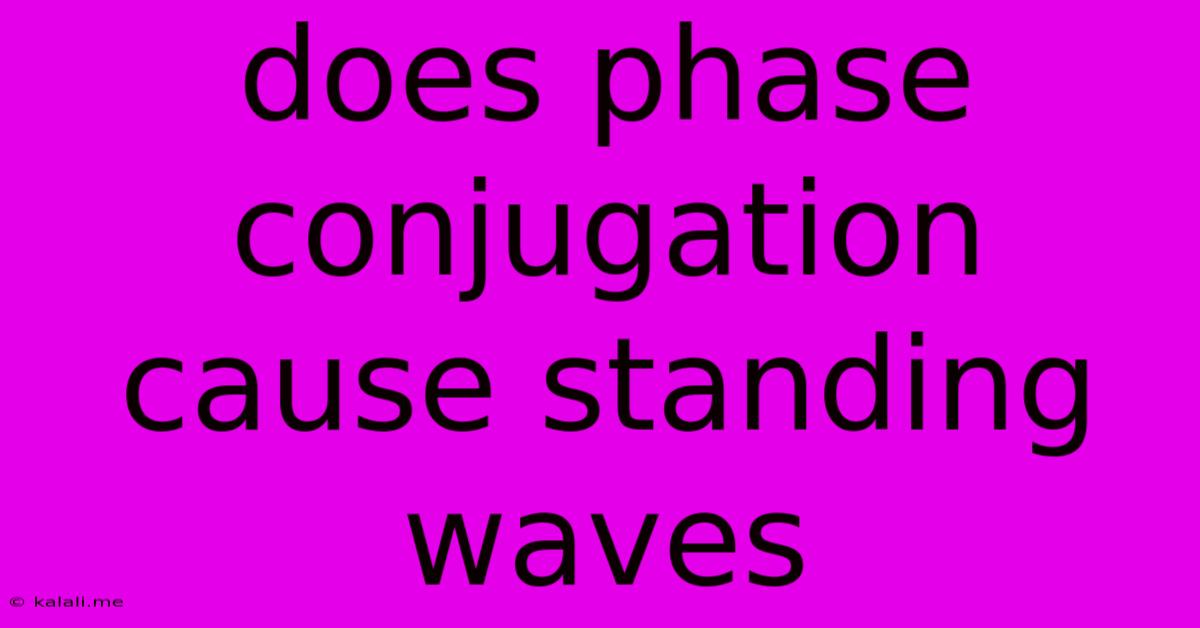Does Phase Conjugation Cause Standing Waves
Kalali
Jun 07, 2025 · 3 min read

Table of Contents
Does Phase Conjugation Cause Standing Waves? A Deep Dive into Nonlinear Optics
Meta Description: This article explores the complex relationship between phase conjugation and standing waves. We delve into the physics behind phase conjugation, its applications, and why, despite initial intuition, it doesn't directly create standing waves in the traditional sense.
Phase conjugation, a fascinating phenomenon in nonlinear optics, often sparks questions about its interaction with other wave phenomena, particularly standing waves. While the initial thought might be that reversing a wave's phase would naturally lead to the creation of a standing wave, the reality is more nuanced. This article will dissect this relationship, clarifying the misconceptions and exploring the underlying physics.
Understanding Phase Conjugation
Phase conjugation is a process where the phase of an incoming wave is inverted. Imagine a wave represented by a complex amplitude: A(r,t) = A₀(r,t)exp[iφ(r,t)], where A₀ represents the amplitude and φ represents the phase. Phase conjugation reverses the sign of the phase, resulting in a wave A*(r,t) = A₀(r,t)exp[-iφ(r,t)]. This effectively reverses the wavefront's propagation direction.
This reversal isn't simply a reflection; it's a more fundamental transformation. A mirror reflects a wave, maintaining the wavefront's shape. Phase conjugation, on the other hand, reverses the wavefront's curvature, effectively undoing any distortions the wave might have experienced.
The Mechanics of Phase Conjugation
Several nonlinear optical processes can achieve phase conjugation, including four-wave mixing and stimulated Brillouin scattering. These processes rely on the nonlinear response of a material to the incident optical field. The interaction of the incoming wave with the material generates a conjugate wave with the reversed phase. The efficiency of phase conjugation depends on factors such as the material's nonlinear susceptibility, the intensity of the incident beams, and the geometry of the interaction. This complex interplay of light and matter underpins the fascinating capabilities of phase conjugation.
Why Phase Conjugation Doesn't Directly Create Standing Waves
The key to understanding why phase conjugation doesn't directly lead to standing waves lies in the nature of the process. A standing wave is typically formed by the superposition of two waves traveling in opposite directions with the same frequency and amplitude. While phase conjugation generates a wave traveling in the opposite direction, it doesn't inherently guarantee the same frequency and amplitude as the original wave.
Furthermore, the phase-conjugated wave originates from a nonlinear process within a material. The interaction is complex, and the resulting conjugate wave may not perfectly overlap spatially or temporally with the incident wave, even if it travels in the opposite direction. Perfect overlap, necessary for a complete destructive or constructive interference resulting in a stationary standing wave, is rarely achieved. The slight discrepancies prevent a true standing wave pattern from forming.
Applications of Phase Conjugation
Despite not directly generating standing waves, phase conjugation has numerous significant applications:
- Adaptive Optics: Correcting for distortions in optical systems, particularly in astronomy and laser technology.
- Optical Phase Conjugate Mirrors: Used to compensate for aberrations in laser beams, improving beam quality and focusing efficiency.
- Holography: Playing a role in creating and manipulating three-dimensional images.
- Nonlinear Microscopy: Enhancing image resolution and contrast.
Conclusion
In summary, while the concept of phase conjugation seems intuitively linked to the generation of standing waves, the actual mechanism doesn't support this conclusion. Phase conjugation reverses the wavefront's propagation, but the conditions for forming a standing wave – identical frequency, amplitude, and perfect spatial and temporal overlap – are generally not met. The process's profound applications in various fields highlight its significance despite its lack of direct involvement in standing wave formation. Understanding the subtle differences between reflection, interference, and phase conjugation is crucial to grasping the true nature of this remarkable nonlinear optical phenomenon.
Latest Posts
Latest Posts
-
Strong Voice Scolding Child But Cant See His Face
Jun 07, 2025
-
Scientists Never Stopped To Think If They Should
Jun 07, 2025
-
How To Fix A Molly Hole In Concrete Slab
Jun 07, 2025
-
Questions To Ask About The Butterfly Effect
Jun 07, 2025
-
How Does A Generator Make Electricity
Jun 07, 2025
Related Post
Thank you for visiting our website which covers about Does Phase Conjugation Cause Standing Waves . We hope the information provided has been useful to you. Feel free to contact us if you have any questions or need further assistance. See you next time and don't miss to bookmark.